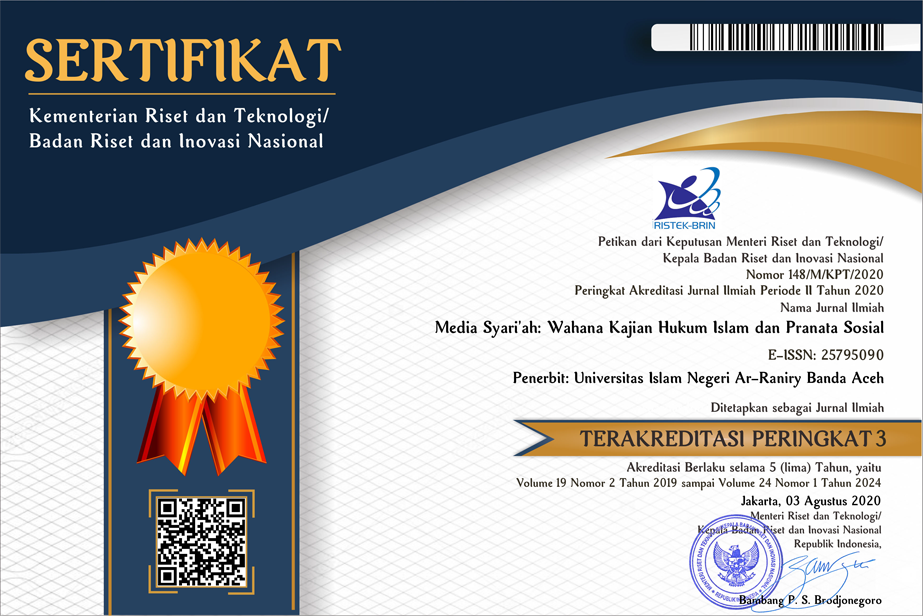References
li, S. A. (2002). Islamic Fire. Pembangunan.
An-Nadwi, A. H. A. al-H. (2006). Sirah Nabawiyah Complete History of the Prophet Muhammad SAW. Mardhiyah Press.
Anello, G. (2021). The Concept of “Contractual Citizenship” in the Charter of Medina (622 C.e.): A Contemporary Interpretation. SSRN Electronic Journal. https://doi.org/10.2139/ssrn.3784632
Aqimuddin, E. A. (2016). Islam Sebagai Sumber Hukum Internasional. Jurnal Masalah Masalah Hukum, 45(4).
Arkoun, M. (2003). Rethinking Islam Today. The ANNALS of the American Academy of Political and Social Science, 588(1), 18–39. https://doi.org/10.1177/0002716203588001003
Bakar, I. A. (2008). History of Islamic Civilization. UIN-Malang Press.
Bouzenita, Anke I. (2011). The Principle of Neutrality and “Islamic International Law” (Siyar). Global Jurist, 11(1). https://doi.org/10.2202/1934-2640.1377
Bouzenita, Anke Iman. (2007). The Siyar — An Islamic Law Of Nations? Asian Journal of Social Science, 35(1), 19–46. https://doi.org/10.1163/156853107X170150
Eickelman, D. F., & Anderson, J. W. (1999). New Media in the Muslim World The Emerging Public Sphere. In Indiana University Press. Indiana University Press.
Ilham, M., Amiruddin, M. M., & Arif, A. (2020). Islamic Harmony Examplar: The Qur’an’s Frame on Social Interaction with Non-Muslims. FITRAH: Jurnal Kajian Ilmu-Ilmu Keislaman, 6(2), 191–206. https://doi.org/10.24952/fitrah.v6i2.2777
Jonathan Bloom, & Sheila Blair. (2002). Islam: A Thousand Years of Faith and Power. Gardner Films.
Koller, J. M. (2004). From the Prophet to the Present: An Historical Approach to Understanding Islam. The Journal of Comparative Asian Development, 3(1), 29–50. https://doi.org/10.1080/15339114.2004.9678391
Kusumaatmadja, M., & Agoes, E. R. (2003). Pengantar Hukum Internasional. Alumni.
Lapidus, I. M. (2000). Social History of Muslims. Raja Grafindo Persada.
Linda, L. (2020). The Tasyri of Rasulullah Priode: An Introduction to Islamic Law. Al-Mirah: Jurnal Pendidikan Islam, 2(2), 51–57. https://doi.org/10.33487/al-mirah.v2i2.453
Muthoilah, G. I. (n.d.). The Urgency of Understanding the Tasyri’ Date of the Rosulullah Period to Strengthen Understanding of Islamic Law.
Nugraha, A. T. (2022). Contemporary International Treaties Seen From the Principles of Maqasid Ash-Shariah. Law and Justice, 7(1), 63–75. https://doi.org/10.23917/laj.v7i1.604
Nurhadi, N. (2019). The Importance of Maqashid Sharia as a Theory In Islamic Economic Business Operations. International Journal of Islamic Business and Economics (IJIBEC), 3(2), 130–145. https://doi.org/10.28918/ijibec.v3i2.1635
Rehman, J. (2008). The Sharia and Siyar in the Development of the Law of Nations. Salzburg Global Seminar Session 457.
Sahin, H. (2015). Civil Society Institutions in Pre-Islamic Mecca. In Research Gate. Medipol University.
Said, J. (2001). Law, Religion and the Prophetic Method of Social Change. Journal of Law and Religion, 15, 83–150. https://doi.org/DOI: 10.2307/1051516
Saifullah. (2007). Reflections on the Sociology of Law. Refika Aditama.
Salahuddin, H., & Niaz, A. (2011). Pre-Islamic Arab Judiciary in Islam. Gomal University Journal of Research, 27(2).
Saritoprak, Z. (2002). The Mahdī Tradition in Islam: A Social-Cognitive Approach. Islamic Studies, 41(4), 651–674. http://www.jstor.org/stable/20837234
Syalabi, A. (1983). History of Islamic Culture 1. Pustaka al-Husna.
Thontowi, J., & Iskandar, P. (2006). Hukum Internasional Kontemporer. Refika Aditama.
Tibi, B. (2005). Islam between Culture and Politics. Palgrave Macmillan UK. https://doi.org/10.1057/9780230204157
Wildan, T. (2023). Principles of the teaching of nation and state life in the Constitution of Medina. IBDA` : Jurnal Kajian Islam Dan Budaya, 21(1), 17–36. https://doi.org/10.24090/ibda.v21i1.6747
Wimra, Z., Huda, Y., Bunaiya, M., & Hakimi, A. R. (2023). The Living Fiqh: Anatomy, Philosophical Formulation, and Scope of Study. JURIS (Jurnal Ilmiah Syariah), 22(1), 185. https://doi.org/10.31958/juris.v22i1.9491
Wiradipradja, E. S. (2003). Principles of International Law in Islam. XIX(2).
 Skip to main content
Skip to main content



.png)


.png)
.png)
.png)




